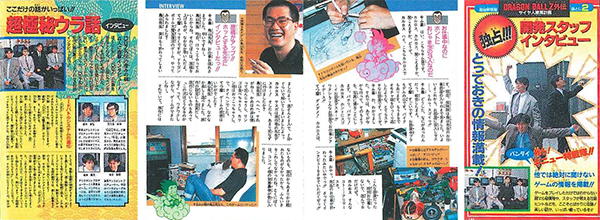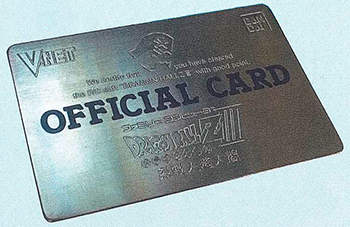30th Anniversary: Dragon Ball Chōshishū –Super History Book–
(21 January 2016)

Video Games Selection – Pick Up! 01
A look back on Dragon Ball games representative of their respective eras. We’ll begin with a long series from the early days!
Expressing the expansion of the Dragon Ball world with cards and role-playing!!
Dragon Ball: The Great Demon King’s Revival and others
A series of “card RPGs” that began with the Famicom’s The Great Demon King’s Revival. By mixing elements of a board game-style RPG with card gaming, a completely new system was born. With every new title, things like the activation of finishing moves through a combination of 3D battles and a card gaming system continued to evolve and bolstered Dragon Ball games for a long time.
Series Data
Dragon Ball: Daimaō Fukkatsu (“Dragon Ball: The Great Demon King’s Revival”)
• Gaming system: Famicom
• Release Date: August 1988
Dragon Ball 3: Gokū-den (“Dragon Ball 3: Goku’s Legend”)
• Gaming system: Famicom
• Release Date: October 1989
Dragon Ball Z: Kyōshū! Saiya-jin (“Dragon Ball Z: Assault! The Saiyans”)
• Gaming system: Famicom
• Release Date: October 1990
Dragon Ball Z II: Gekishin Furiiza!! (“Dragon Ball Z II: The Violent God, Freeza!!”)
• Gaming system: Famicom
• Release Date: August 1991
Dragon Ball Z: Super Saiya-jin Densetsu [sic]1 (“Dragon Ball Z: The Super Saiya Legend”)
• Gaming system: Super Famicom
• Release Date: January 1992
Dragon Ball Z III: Ressen Jinzōningen (“Dragon Ball Z III: A Violent Battle With the Artificial Humans”)
• Gaming system: Famicom
• Release Date: August 1992
Dragon Ball Z Gaiden: Saiya-jin Zetsumetsu Keikaku (“Dragon Ball Z Side-Story: Plan to Eradicate the Saiyans”)
• Gaming system: Famicom
• Release Date: August 1993
All titles above released by Bandai
Memorial Interview: Nobuyuki Tanaka
Producer of the Dragon Ball card RPG series
“We gathered at Shueisha at 2:00 a.m. and waited for a fax from Sensei.”
 PROFILE: Worked as producer from Dragon Ball 3: Goku’s Legend to Dragon Ball Z: The Super Saiya Legend.1 He also worked on many other game adaptations of Jump properties.
PROFILE: Worked as producer from Dragon Ball 3: Goku’s Legend to Dragon Ball Z: The Super Saiya Legend.1 He also worked on many other game adaptations of Jump properties.
[caption] Sitting alongside Mr. Tanaka was Mr. Suzuki2, who worked under him at the time and was also was involved with the latter half of this “series,” which included the Plan to Eradicate the Saiyans games.
Suzuki: It was even worse when we moved onto Z and the world became even bigger.
Tanaka: Exactly. The battles started playing an even bigger part in the original comic, so it became important to figure out how to express that in a game within the limits of the Famicom. So that’s why, even though we kept the card gaming system, we made an animation trigger depending on the effects of the card. They gave some perception of depth, as if they were 3D, but since they were actual animations and not mere drawings, they obviously took up a lot of space on the cartridge. By doing things like making the background completely black, we managed to save up some of that space.
Tanaka: This doesn’t apply to just the games; when it comes to Dragon Ball, everything moves super fast from the planning stages to actual development. A lot of companies and people start getting involved. I guess it just goes to show how powerful the original material is.
Secret Files
Articles in the Strategy Guides
Since these are old titles, there isn’t much documentation left, but the strategy guides printed at the time include a number of articles where valuable testimonies still remain, such as interviews with Toriyama-sensei and the development staff.
Plan to Eradicate the Saiyans Strategy Guide Staff Interview
A part of the guide that includes an interview with the development staff. It’s packed to the brim with inside stories from the game’s production, such as the fact that Toriyama-sensei provided a fairly detailed backstory for the Tsufruians.
The Great Demon King’s Revival Strategy Guide Toriyama-sensei Interview
A magnificent article describing a visit to Toriyama-sensei‘s studio and private residence. Included are plenty of photographs showing a rare side of Sensei, including him relaxing at his house.

A Carefully Crafted V.NET Official Card
A metal card granted by V.NET, Weekly Jump‘s gaming corner at the time, as a gift to anyone that managed to clear A Violent Battle With the Artificial Humans.
[caption] A very dignified golden card with the logo engraved on it. Produced by Bandai.

A not-for-sale, limited-edition illustration included with The Violent God, Freeza!!

An illustration included as a present inside all limited-edition copies of The Violent God, Freeza!! It was a brand-new drawing made by Toriyama-sensei himself.
[caption] A powerful illustration of a clash between Goku and Freeza. It was also used as a foldout poster inside the Jump magazine itself.
2 The original text never specifies Suzuki’s first name just yet, but it does so later on in the second interview: this is Toshihiro Suzuki, producer of several Dragon Ball games of this early era, notably the Super Butōden series. Curiously enough, Suzuki was never affiliated with the Saiya-jin Zetsumetsu Keikaku games themselves.
3 Which at the time would have been Kazuhiko Torishima.
4 Dragon Ball Z III: A Violent Battle With the Artificial Humans rather infamously ends with the battle against second-form Cell; they truly were that close and caught up with the content from the original manga serialization! This is the reason why the next (and final) Famicom game, Plan to Eradicate the Saiyans, was a wholly-original story.
5 “Original Video Animation”: a direct-to-video feature. In the case of Plan to Eradicate the Saiyans, a mini multimedia empire was built including the original Nintendo Famicom game as well as a two-part VHS feature presentation, a two-part Bandai Playdia game series, guidebook, and soundtrack CD.